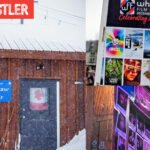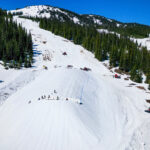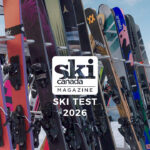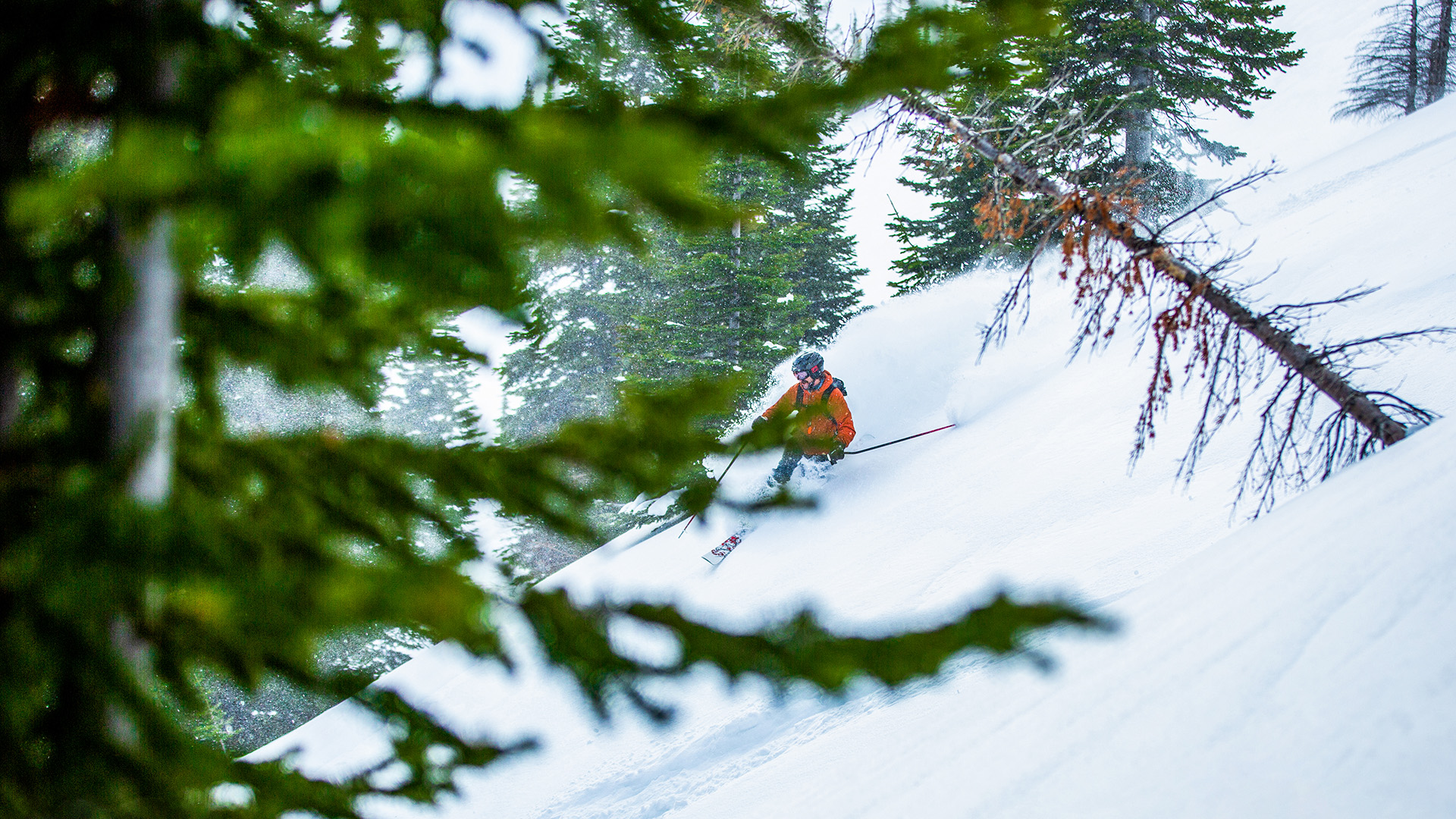
NO MATTER WHICH WAY THE WIND BLOWS—AND IT BLOWS HARD—UNIQUE SKIING AND LOYAL LOCALS HAVE PUT CASTLE MOUNTAIN ON FIRM FOOTING.
The top station of Red Chair doesn’t offer a compelling reason to hang around instead of going skiing. There’s no day lodge with a sun deck, no photographer waiting to take your photo with a drooling St. Bernard. There was, on my first trip up, a man expertly lassoing another from about 10 paces, but it wasn’t a demonstration or routine, it was more off-season practice. The men, my hosts explained, were ski patrollers by winter, ranchers the rest of the year.
Castle Mountain is in the Canadian Rockies, but only just barely. Foothills are scant here, 35km north of the Montana border. The prairies start at the bottom of the valley, with few curves in the roads from here to midway through Manitoba.
This geography looms large at Castle for two reasons. First, it makes the valley a funnel for Chinook winds that can’t wait to scream downhill to the wide-open prairies after being pushed up and over B.C.’s mountains. I’ve always viewed wind as a threat to a snowpack. At Castle, skiers consider it an ally, a huge snow gun that blows fresh snow from the windward mountains for days on end after a storm.
The prairie-side setting also supplies the operation—which is a word that fits better than “resort”—with a hands-on and knowledgeable set of locals. The kind you would want on your side, in your work crew, if you were going to go about building a ski area from the grassroots up, which is exactly what has happened twice at Castle Mountain over the last 57 years.

Klaas then set about creating a ski culture in southern Alberta.

ALBERTA BOUND
Paul Klass was born in 1921 in Klosters, Switzerland. Being the youngest of 14 kids, he must have found the valley cramped. He hopped on a ship, got off at Halifax and rode the train until he saw mountains, settling in southern Alberta to ranch in 1953.
Klaas had left a valley that claimed to be the birthplace of modern skiing to plant himself in a place where locals would have heard about people skiing in Banff, but probably didn’t really believe people would strap fence rails to their feet to slide down mountains. He then set about creating a ski culture in southern Alberta.
He spent five years exploring the mountains on horseback, dismounting when he found Gravenstafel Ridge, with its 2,300m elevation, sparse tree cover and steep, consistent pitch. His next job was to convince those living between Pincher Creek and Lethbridge that what the area needed was a ski resort. According to local historian Steven Kenworthy, to show potential investors the site, he put them on skis and towed them up the valley behind a tractor, camping overnight. Somehow, it worked. As Kenworthy wrote in A History of Castle Mountain Resort, locals formed a corporation and sold $10,000 shares (some split among friends) around the area. Construction started in 1964.
Much of what happened next was done through force of will—Klass’ and that of his neighbours, some of whom happened to own construction companies, most of whom knew how to operate machinery and all of whom knew how to work.
According to Kenworthy, in absence of proper survey equipment, Klass painted an X on a sheet of plywood, put it halfway up the mountain and told a crew to cut a line to it. The concrete for the T-bar towers that followed in the trail crew’s path would be mixed by hand, no small feat considering the T-bar, named T-Rex, ran for 1.4km, rising 520 vertical metres.
While one crew was mixing concrete another was building walls for the base lodge. Not a roof, mind you. That first winter the lodge was covered by a tarp held down by hay bales. Day tickets for the 1966 season were $4, allowing access to the three T-bars that would serve visitors for the next 30 years.
When it was time to down tools and pick up skis, some had second thoughts. Kenworthy quotes original ski patroller Charlie Russel as saying many thought they had picked the wrong mountain. “There was a lot of steep terrain for a start-up situation.” Russel set about modifying the patrol toboggans so they’d be more suitable, installing larger fins for better control and hanging heavy chains on the front to control speed. “Gravenstafel made good skiers out of people in a hurry,” said Russel.
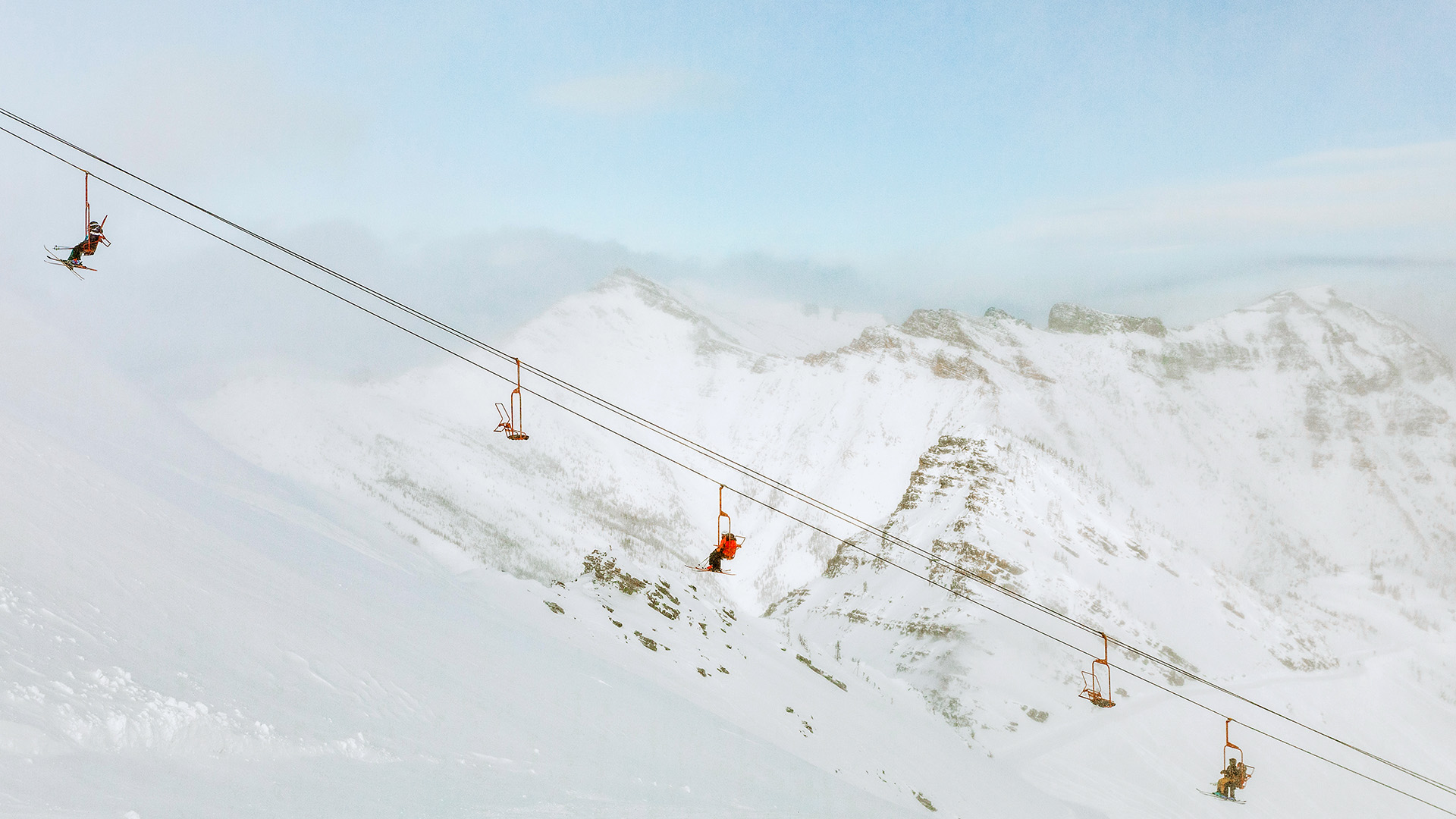
CHEESE, PLEASE
I got a sense of what Russel was talking about at the close of last January as I followed Calgarian and Castle-cabin-owner John Clarkson off the Red Chair, past the wrangling patrollers, under a ranch-style gate toward The Chutes. The trail map shows that this aspect hosts 17 parallel black lines. It looked promising, but I wasn’t prepared for what unfolded in front of me. There is something about the exposure at Castle that distorts perception. There are few gullies, very sparse tree cover, a sustained pitch without many convex rolls to disrupt sightlines. I started down Drifter toward the Buffalo Flats catchment run below, except the Flats failed to get any closer. Long GS turns followed one after another on a pitch that demanded a proper finish to every turn. The thighs started to ache but the bottom was in no hurry to offer relief.
The whole southeast face of the mountain serves up similar wide-open, fall-line skiing on a sustained pitch, but these were neither groomed cruisers nor bumped-up backsiders. I eventually caught up with Clarkson and we went for another lap, this time with his base-area neighbour, Kevin Wright. As Wright and I rode the Red Chair, passing over occasional bare sections of exposed scree, he explained the secret of Castle’s utterly unique snowpack. “It’s our 20-million-horsepower groomer,” he said, talking about the wind, “It blows it flat every night.” He recounted once thinking his vehicle’s transmission was jamming while driving into a headwind on his way up the valley road.
Wind has a bad rap among skiers as something that can ruin a snowpack as surely as a thaw/freeze cycle, but at Castle the wind is spoken of in reverent tones. “We don’t have Banff’s marketing budget, but we have something they don’t have,” says Wright. “The wind does us wonders here. It means three powder days in a row.”
Kyle Rast has worked at Castle for a quarter century, mostly on patrol, and has further insight into what makes Castle’s snow different. “The Chinook winds can be exceptional. The drift skims everything over, and fills in all the depressions, so it never bumps up.”
Beyond keeping the slopes smooth and fast, the snow that is blown in from the windward side of the mountain has a different feel. Rast refers to the wind-transported snowflakes as “decomposed fragments.” They aren’t flakes anymore, but crystals with their arms broken off. The result is a buttery wind sift that’s soft, yet supportive. “You sink in a bit,” Rast says, “not too far, just enough to carve anywhere you want. It’s fast, carvable, edgeable, but never hard. We call it cream cheese.”
It brings challenges for the ops crew. An area can go from bare rock to four feet of snow overnight, or the opposite. The constant filling in of gullies and lee slopes means that Castle has to maintain one of the biggest avalanche programs in Western Canada, despite having just one alpine chair.
And it’s not just snow that blows in over the ridge, but rocks also. There were sections of cat track near the top that I found impossible to navigate without skiing over a fine layer of shale flakes delivered by the wind. Ski patrollers sometimes put down their lassos and ski with hockey sticks to clear larger rocks that have dropped from the sky.
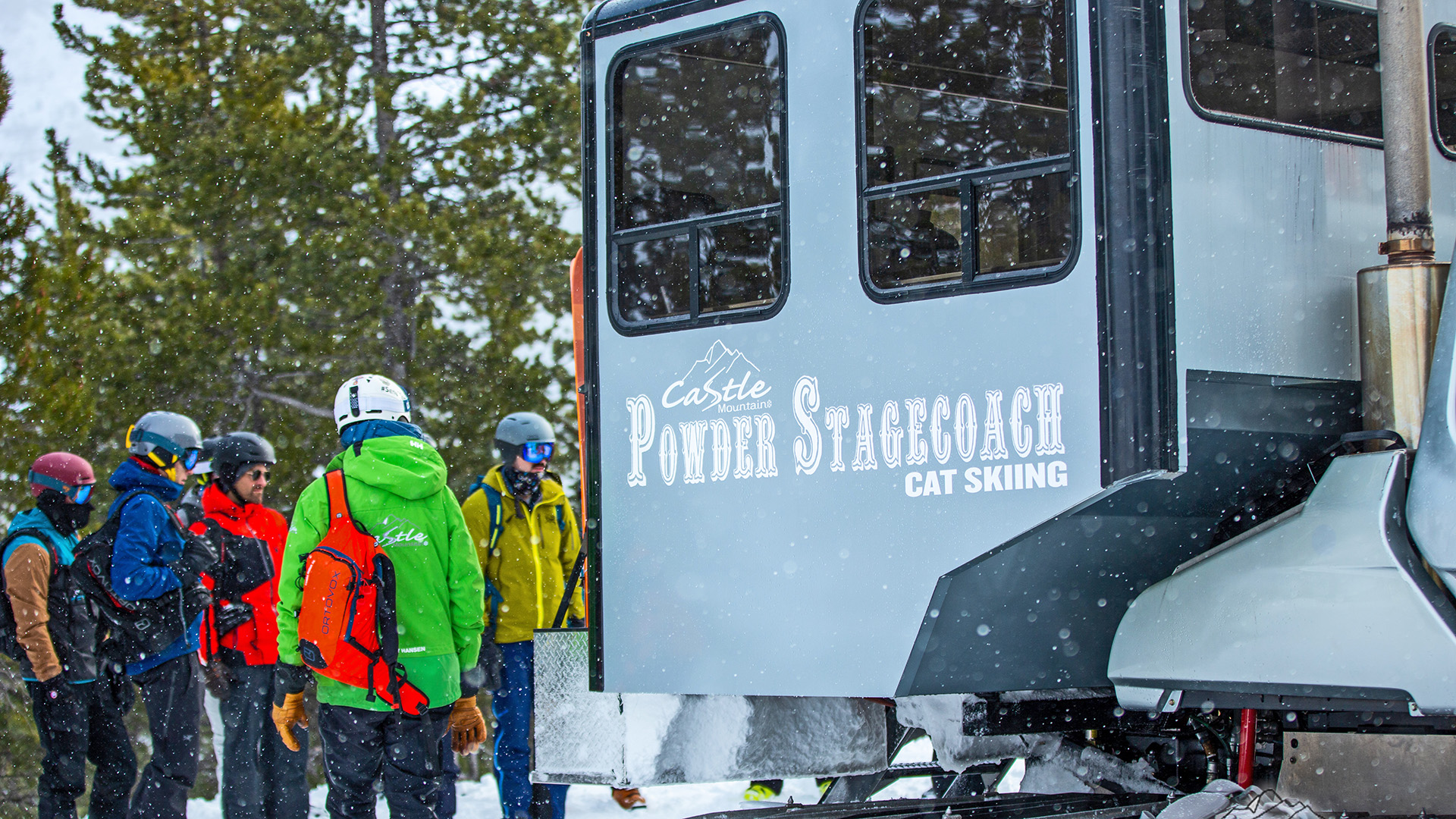
FROM THE ASHES
Ski conditions are preserved by a lift system that treads lightly on the terrain. A triple chair on adjacent Mount Haig opened up more intermediate terrain in 2006, but Castle proper is served by a base area triple chair and summit double chair (officially named Tamarack, known as Red). Clarkson describes the business model supporting this modest infrastructure as always being “a day late and a dollar short.” He makes that observation with a background in the financial industry, but also as a part owner, being among a second wave of shareholding skiers to own the ski area.
Bookkeeping records for the 1965 shares went up in smoke during a 1977 base lodge fire (solid roof and all). By the early ’80s the resort had been taken over by the local municipality, despite grumblings about whether public dollars should be involved in a ski hill. By the mid-’90s the municipality was about to close the resort. Once again the call went out for skiers to buy shares. Fifty-five $20,000-shares were sold at first, each one granting a 20-year lease on a lot in the trailer park base village.
The municipality essentially just transferred ownership, so the money raised went toward a new day lodge (to replace the five Atco trailers that had been serving as a base hub since the 1977 fire) and two new chairlifts, one of which would head to the top of Gravenstafel.
Once again, lift installation was very much an in-house project.
Derril Murphy was a businessman from Lethhbrige who first rolled a trailer out to Castle in the 1980s. As a 1996 investor, he remembered the helicopter hired to place the towers being underpowered. Kenworthy quotes him: “Some towers would hit the ground and swing around. There were a few injuries, but minor ones. Every one of us dove out of the way at least once.”
With disaster narrowly averted, what was arguably the longest uninterrupted fall-line skiing in Canada took shape above the Alberta prairies.
But there was one condition put in place by the municipal bean counters. Lots could only be occupied by mobile trailers. No foundations were to be dug and laid. With the venture doomed to fail, the municipality didn’t want derelict buildings in a valley abandoned by skiers. Twenty-seven years later, the terrain served by those first two chairs draws ever-wider circles of skiers who want a piece of what the true-believer locals have built.
My first day at Castle ended with a contented glide through the cozy village formed by those shareholder lots. The trailers-only clause appears to be another part of Castle’s history. People here don’t refer to their accommodations as ski chalets. In true frontier style they call them cabins. Clarkson’s cabin is a sturdy two-storey structure with large windows through which he can watch snowdrifts pile up outside. No matter how windy it gets, that cabin isn’t moving. Like the resort it supports, it’s built on very strong foundations.
BY THE NUMBERS
Vertical drop: 870m
Top elevation: 2,295m
Skiable terrain: 1,454ha
Annual snowfall: 8.5m
Chairlifts: 4
Adult day pass: $130
Multi-pass: Indy
GETTING THERE
The road to Castle has been paved since 2018. It’s a 2.5-hour drive from Calgary and 1.5 hours from Fernie.
STAYING THERE
On-site options are simple. The Castle Ski Lodge offers hotel-style or hostel-style rooms across the parking lot from the day lodge. Many lot owners put their cabins up for short term rental. skicastle.ca

